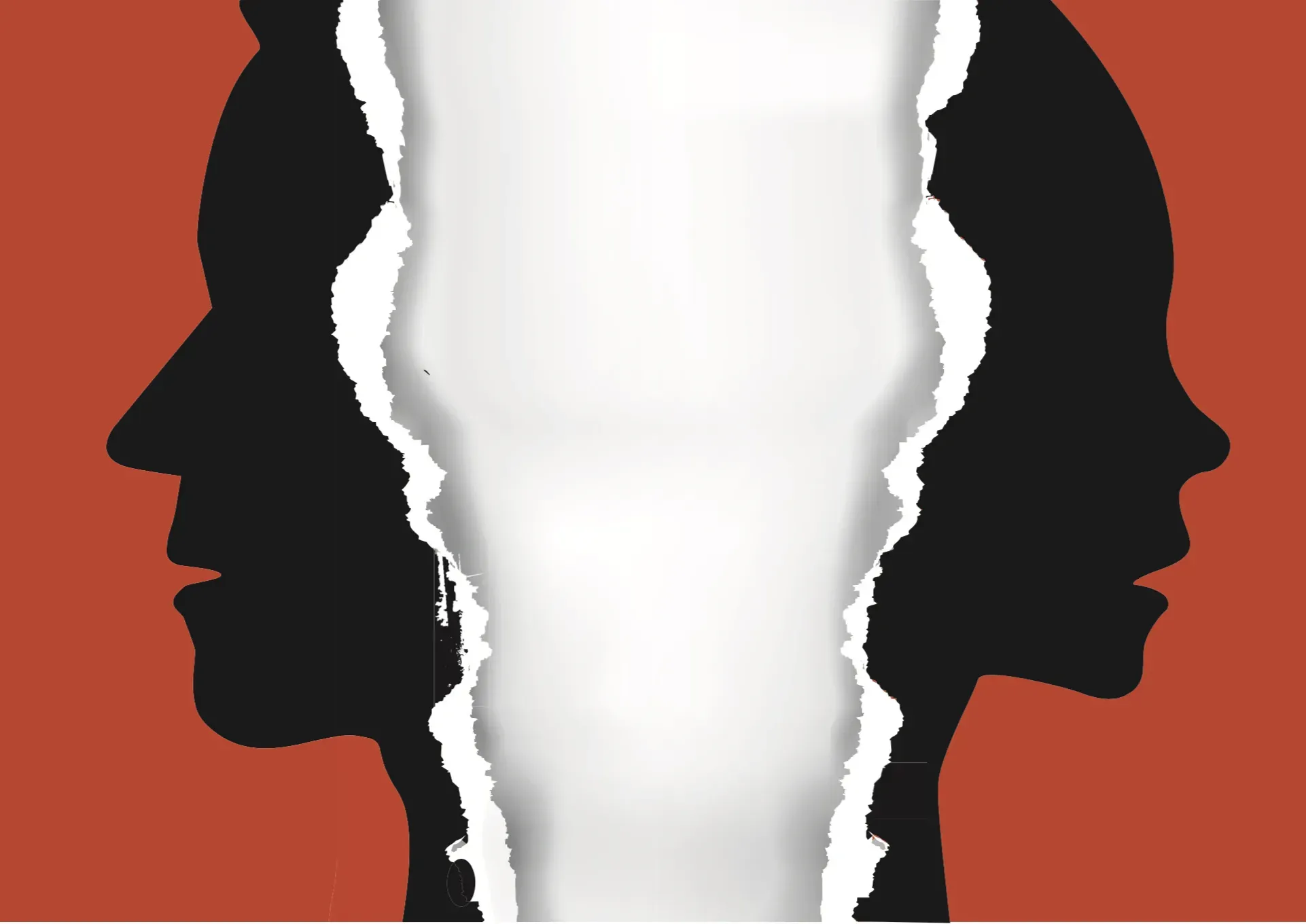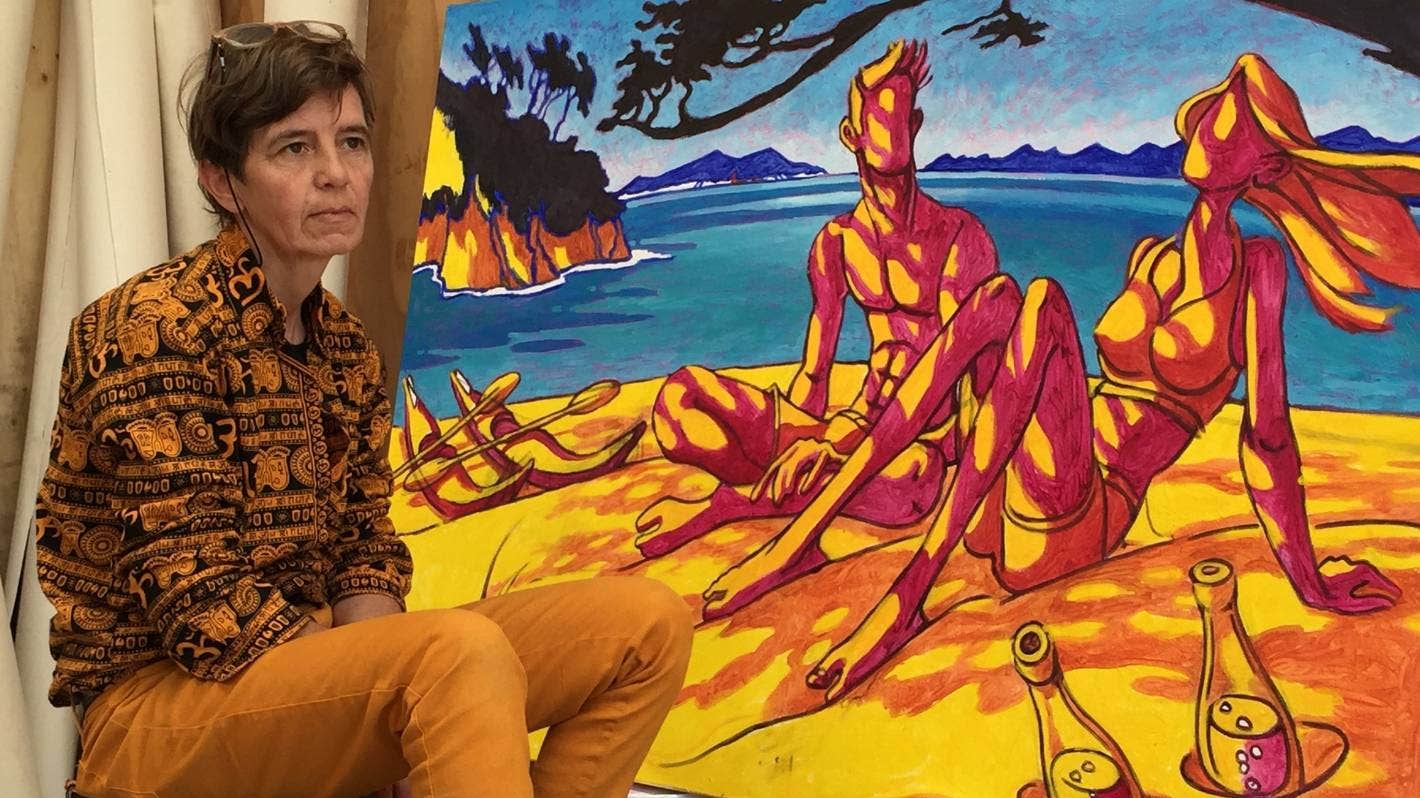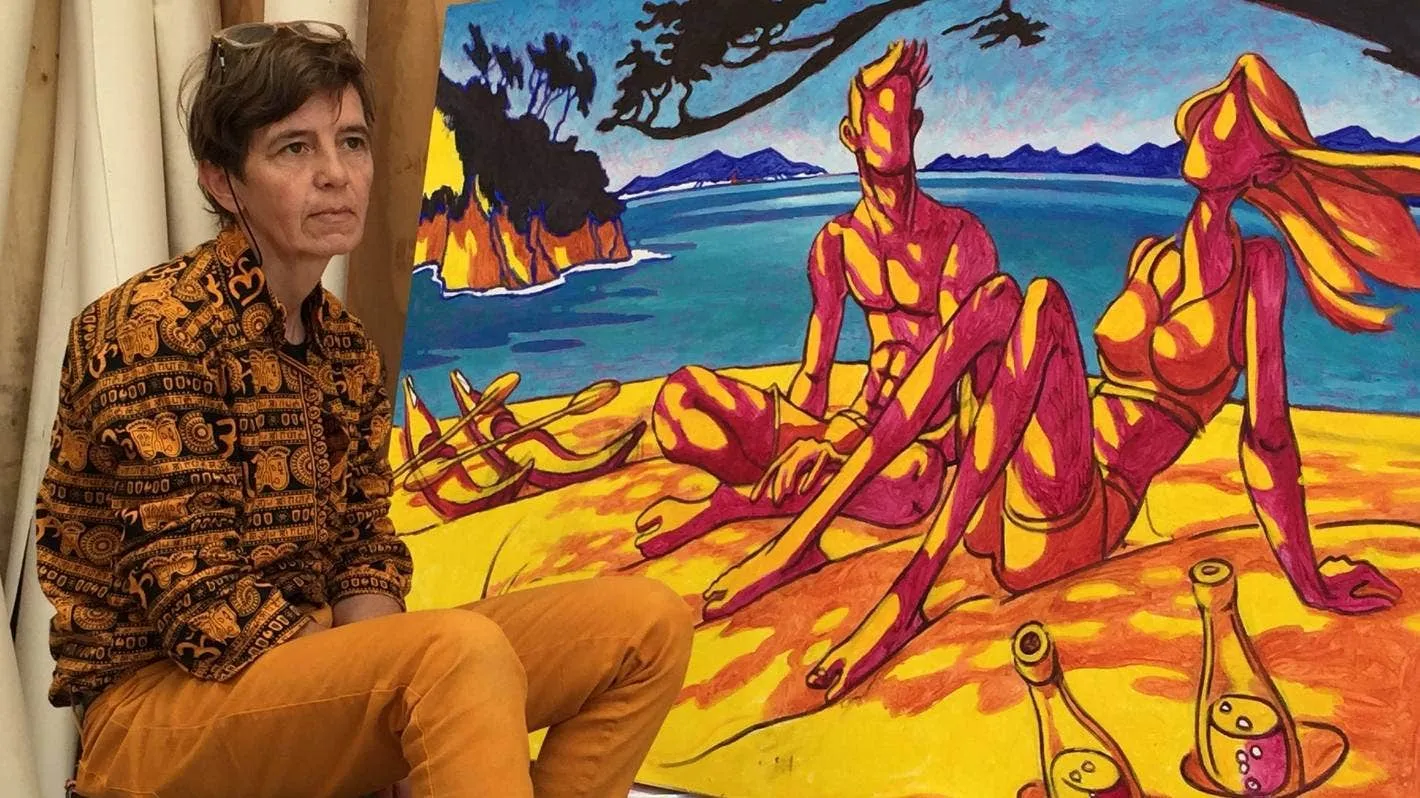Til Art do us Part? Creative Copyright in Divorce

Something potentially significant for creative workers has passed with barely a flicker of attention in a Blenheim High Courtroom. Its implications are immense.
It all starts with a divorce.
Marlborough painter Sirpa Elise Alalääkkölä separated from her husband Paul Anthony Palmer after 20 years of marriage back in 2017. They went to the Blenheim Family Court to divide their property, including their Marlborough Sounds home and the paintings Alalääkkölä created during the marriage.
The ruling was given in 2020 and it was mostly what you would expect. The judge also ruled that the Copyright Act 1994 vested full copyright of the paintings to Alalääkkölä as her ability to create them pre-existed the marriage and copyright could not be considered relationship property.
The judge ruled that Palmer could keep the paintings Alalääkkölä agreed he could.
Then things took a turn vaguely reminiscent of Tim Burton’s 2014 biopic Big Eyes.
Palmer had already tried to assert control over the paintings, having removed 200 works from the artist’s studio after the separation for “leverage”.
Palmer appealed the Family Court ruling at the Blenheim High Court in front of Justice Andru Isac, seeking equal share of the paintings and their copyrights. These he intended to copy and sell as an income.
Justice Isac’s recently released decision stated that the Copyright Act and the Property (Relationships) Act 1976 interacted in an unusual way not previously seen in New Zealand law, forcing the Family Court Judge into new territory.
The Big Idea took this to the experts to find out some of the possible implications of this decision.
Auckland arts and media lawyer Josie McNaught - also a former arts journalist - had this to say:
“Technically this is not a surprising conclusion but it was treated as a novel point in New Zealand family law. However, the huge value that intellectual property rights can acquire in the hands of famous authors or performers means this issue has been hotly litigated overseas.”
Similar issues had previously been explored in the United States. Prominent among these cases and cited by Justice Isac, was one in which the appellant husband wrote and published two books on trivia. In their 1982 divorce decree, husband and wife agreed to divide the royalties equally.
Then in 1984 the husband filed in Federal Court against the makers of the Trivial Pursuit boardgame, alleging that they had plagiarised his books. Then the wife sought and was awarded an order from the Superior Court, granting her half of any proceeds from that lawsuit.
On this basis, Justice Isac overturned the Family Court decision, finding that copyright of an artistic work is relationship property. The finding has some disturbing implications for creative makers in the precedent it sets:
Copyright had long been understood in law to be property. Nothing in the Copyright Act suggests it is different to any other sort of property produced during a relationship.
The Property (Relationships) Act requires property to be divided equally, except in extraordinary circumstances.
As there was no established inventory of the total number of paintings, many having been purchased by collectors, some of which were in Alalääkkölä’s native Finland, Justice Isac believed that an equal split would be difficult by value or number.
He also ruled that the Family Court judge only allowing Palmer to keep those paintings Alalääkkölä agreed to would preclude Palmer receiving a half share.
The case was ordered back to the Family Court with the proviso that Palmer should not assume rights to specific paintings, and if the pair’s differences could not be resolved, the paintings and their copyrights would be subject to court evaluation and split that way.

Artist Sirpa Alalääkkölä. Photo: Adele Redmond/Stuff.
While the New Zealand Law Commission doesn’t usually pass comment on individual cases, in 2020 it called for an overhaul of the Property (Relationships) Act, citing issues with property being brought into a marriage changing value and thus making equitable 50/50 splits difficult without an involved valuation process.
They recommended undertaking valuation beforehand. This is somewhat complicated as evaluating contemporary art is difficult at the best of times. It’s certainly outside the narrow remit of the existing Copyright Tribunal.
Caroline Stone, a legal consultant specialising in copyright licensing, welcomes more public discussion like this around the topic of copyright.
“Copyright is important, and it is great to see the courts recognising its value,” she says, “but it’s hard enough to enforce as it is - this issue adds another layer of complication.”
Stone suggests that expanding the services of the Copyright Tribunal to deal with these sorts of issues might help. “What is the copyright worth now?” asks Stone, “and what will it be worth in 70 plus years time? I am not sure who is qualified to decide that.”
“Of course,” says McNaught, “as fame beckons, many artists take steps to protect their assets by prenuptial settlements and other devices so this case may largely represent a failure to implement a timely defence.
“This is probably the biggest ‘take away’ for New Zealand artists and their dealers. Many law firm’s websites include enticing claims they can solve this problem.”
On the one hand, it’s very easy to see why the Family Court judge was reluctant to define Copyright as the same as other property in the normal sense. On the other, Justice Isac is quite correct within the law.
Specifically of the Alalääkkölä case, McNaught observes:
“Unfortunately, the intractability of the parties, and their unwillingness to be represented by counsel in the Family Court – Palmer was represented in the High Court, Alalääkkölä was not – meant not all the relevant issues were tidily before the courts.”
Implications for creatives
The looming question is what this means for other artists/creators in New Zealand.
Depending on how the Family Court addresses the particular assets, it could - for example - have implications for authors’ and publishers’ royalty payments, although the contract between author and the publisher would likely need a court order for publishers to split royalty payments.
But it’s unlikely that in the event Steven Spielberg stumbles across your self-published novel from married days and wants to make a movie out of it that your ex-spouse will be entitled to half the proceeds of the film rights. When the relationship split, the asset would in that case not have a high valuation allocated to it, because this chance was not foreseen.
William Somerville, a retired former tax partner with PricewaterhouseCoopers, explains:
“Value changes after a property agreement has been finalised accrue to the individual who took that item of property. Future events can then create winners and losers but, unless there was some kind of misrepresentation or concealment at the time of the agreement, it is not possible to make a retrospective claim.”
In visual arts, except in the case of you commissioning an artwork, when you buy an artwork, you don’t buy the copyright – that remains with the artist.
But apparently, now that could remain with the artist and their ex-spouse if the copyright has been split into joint ownership in the property agreement or Family Court order, which would admittedly be an exceptional case because assets are not usually left in joint ownership.
Otherwise, Somerville says, “there is only an inchoate claim by the partner who didn’t create the copyright. Such a claim would not, generally, bind third parties until it is perfected by agreement. Of course, the law also has many protections for innocent third parties facing disputed ownership of an asset.”
This will potentially impact public museums and art galleries that purchase art for their collections in terms of negotiating merchandise and publication.

Photo: Shutterstock.
In the decision, Justice Isac indicates some concern for issues arising from joint ownership of copyright:
“In this regard, the Family Court’s discretion in relation to vesting orders is broad. It should not be assumed that the only order open to the Court is one vesting ownership of specific paintings in one party or the other. The same consideration applies to division of copyright in the artworks.
“It would be possible, for instance, for some, none or all of the works to be vested in one party, with an adjustment to the division of the proceeds of sale of the family home in order to obtain overall equality of division. And, there is no requirement that copyright in a work must follow an order vesting the work in one party or the other. Those matters are entirely at large, and for the Family Court to determine.”
That is quite the ask of the Family Court, but the same principle usually applies to other assets remaining in joint ownership with the Property (Relations) Act avoids where practical.
Know your moral rights
According to Earl Gray, an independent Barrister with Sangro Chambers in Auckland - who specialises in copyright and other intellectual property matters - creators have other additional rights known as moral rights that exist alongside but independent of copyright and are defined in Part 4 of the Copyright Act.
These include attribution, the right to be identified as the author of a work (the right of attribution); integrity, the right to object to derogatory treatment of the work; and the right not to have a work falsely credited to them.
“Moral rights,” says Gray, “are not understood to be property; they are seen as a form of extension of personality. Ms Alalääkkölä remains entitled to exercise her moral rights to be identified as author and to object to derogatory treatment.”
Derogatory treatment in copyright law means reproducing, altering or adapting the work in such a way that it amounts to a distortion or mutilation of the work, or is otherwise prejudicial to the reputation of the creator. Gray notes that the precise parameters of the artist’s right to object to derogatory treatment are not clear-cut, which may have implications for Palmer’s attempts to monetise the copyright - which in turn affects the value of the copyright because Palmer is not totally free to deal with the copyright he ends up owning.
Gray cites the District Court case asserting moral rights taken by Auckland artist John Radford against Hallenstein Bros. Ltd over their use of his sculptures in Western Park, Ponsonby on their t-shirts:
“[The] Radford v Hallensteins Bros decision was only a decision denying Hallensteins’ strike out application, so left open questions such as: what needs to be done to a copy of a work to amount to derogatory treatment? Whether simply changing the medium on which a work is produced/reproduced could amount to a treatment?” Says Gray.
Both Gray and Stone suggest that in these cases, a creative practitioner could proactively assert that certain treatments of their works would be regarded as derogatory, in order to place some conditions on how the copyright of their work is monetised.
Somerville notes that there are tax implications where the copyright of the work and the work itself are both relationship property.
“Any value possessed by these two items of property,” says Somerville, “would then need to be accounted in any financial settlement between two separating parties. Isaac’s decision is, necessarily, far from a textbook analysis of how one partner’s business should be dealt on separation.
“However,” Somerville says, “the practical issue of this decision for the artist wife is that her copyright is a capital asset of her business, as opposed to the works themselves which are regularly disposed of as trading stock.
“Most dealers would say that managing your brand is critical and that controlling copyright is a key part of that.”
This might open the door to the peculiar situation where the key capital asset of a single business is split between two warring ex-partners.
“Isac J probably sensed this,” says Somerville, “and fired a warning shot that there should be no expectation by the husband that ownership of the work automatically entitled him to the copyright in the work.
“If, however, business assets do have to be split - because there is no other way to achieve the required dollar value settlement - then a better solution might be for the wife to offer her husband a limited royalty free licence so she retains the underlying copyright and can impose some controls on its exploitation.”
There are also some decidedly tricky tax issues as well.
“The non-artist partner,” Somerville says, “may well find that assets sourced from the business come with a deferred tax liability they wrongly assumed remained with the artist partner.”
“For the rest of us,” McNaught says, “the potential splitting of copyright complicates chain of title for those of us who want to do more than just hang our art on the wall. However, chain of title in the creative sector is frequently split into many components by assignments and licensing agreements so this case will probably be a small ripple in an already turbulent pond.”
Both McNaught and Somerville concur that the case is rather narrow because of the lack of counsel in the Family Court. Artists facing this situation should also know that there are special rules, and complex valuation issues, when a business carried on by one partner becomes entangled in a relationship property dispute.
“How will his case end? We will probably never know,” says McNaught. “It may be settled, otherwise it is headed back to the Family Court where it will be interesting to see if Isac J’s warning shot is heeded.”
Of course, most of the more difficult issues will only arise in the unlikely event of the Family Court ruling that results in two ex-spouses ending up with joint ownership of copyright. This is something that courts tend to try to avoid, as in the case of any small business.
The Big Idea will keep a close eye on how this case develops.

